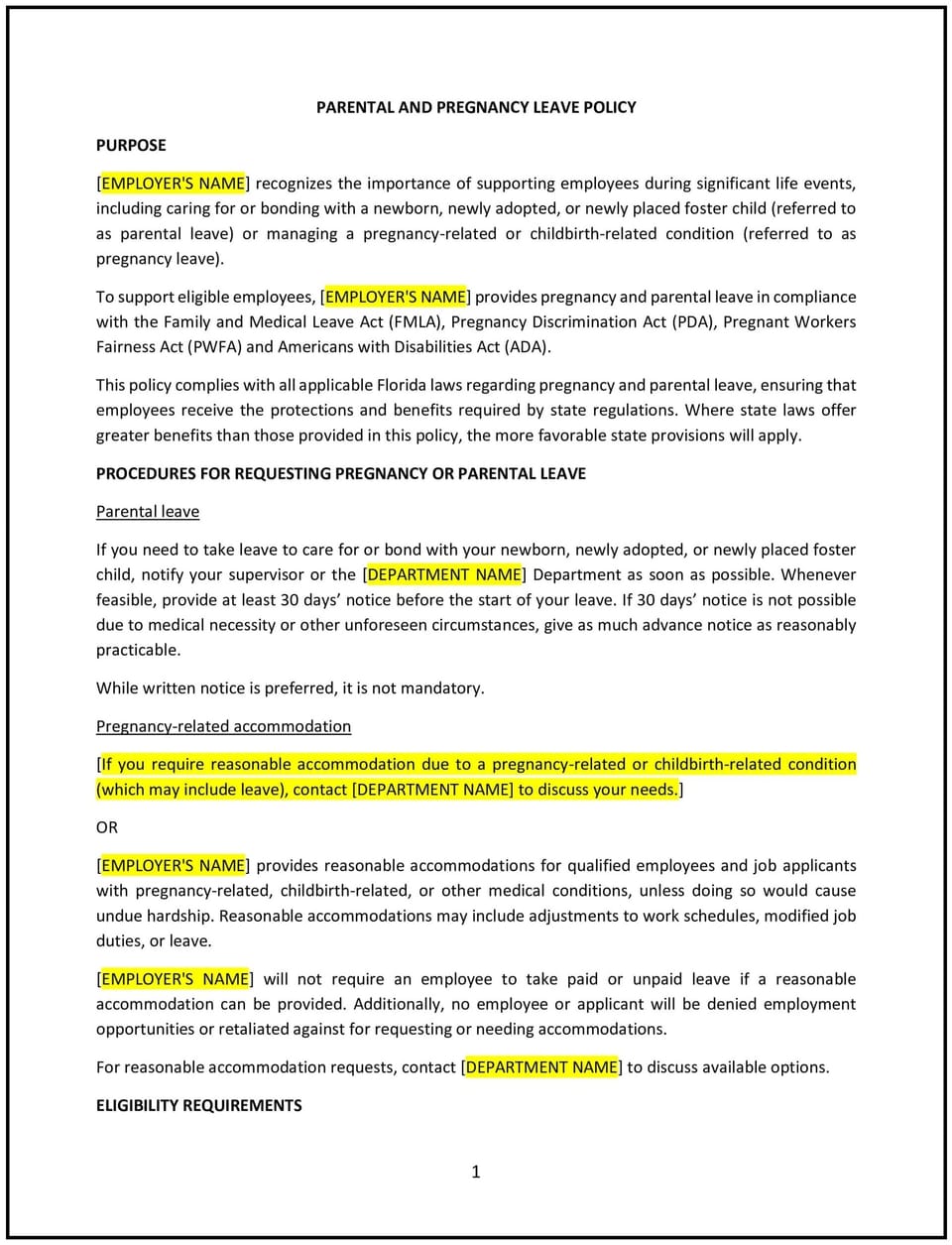Parental and pregnancy leave policy (Florida): Free template

Parental and pregnancy leave policy (Florida)
A parental and pregnancy leave policy helps Florida businesses support employees who are expecting or have recently given birth, as well as those caring for newborns or newly adopted children. This policy outlines procedures for requesting, approving, and managing leave while maintaining operational efficiency. It is designed to promote work-life balance, reduce stress, and provide clear guidelines for handling parental and pregnancy leave requests.
By implementing this policy, businesses in Florida can demonstrate their commitment to supporting employees during significant life events, foster goodwill, and align with the state’s focus on family-friendly practices.
How to use this parental and pregnancy leave policy (Florida)
- Define eligible employees: Clearly specify which employees qualify for parental and pregnancy leave, such as full-time or part-time staff.
- Establish request procedures: Outline how employees should notify the business of their leave, including whom to contact and how to document requests.
- Address leave duration: Explain how much leave is available for pregnancy and parental purposes, including any differences between paid and unpaid leave.
- Specify return-to-work expectations: Provide guidance on how employees should communicate their return date and resume work responsibilities.
- Provide support resources: Offer information about employee assistance programs (EAPs), counseling services, or local resources for support.
- Communicate the policy: Share the policy with employees during onboarding and through regular communications to ensure awareness and understanding.
- Monitor adherence: Regularly review how the policy is applied and address any concerns or discrepancies promptly.
- Update the policy: Periodically assess the policy to reflect changes in workplace dynamics, legal standards, or business needs.
Benefits of using this parental and pregnancy leave policy (Florida)
This policy offers several advantages for Florida businesses:
- Promotes work-life balance: Supporting employees during significant life events helps them manage personal and professional responsibilities more effectively.
- Reduces stress: Providing clear guidelines helps employees navigate leave without added work-related pressure.
- Builds trust: A clear policy demonstrates the business’s commitment to fairness and employee well-being.
- Aligns with community values: Reflects Florida’s emphasis on family-friendly workplaces and mutual support.
- Enhances reputation: Demonstrates the business’s dedication to ethical practices and employee support.
- Improves retention: Offering parental and pregnancy leave contributes to higher employee satisfaction and loyalty.
- Supports growth: A robust policy facilitates a more engaged and productive workforce.
Tips for using this parental and pregnancy leave policy (Florida)
- Communicate clearly: Ensure employees understand the policy by providing written materials and discussing it during meetings or training sessions.
- Train managers: Educate supervisors on how to handle parental and pregnancy leave requests sensitively and consistently.
- Be flexible: Allow for reasonable adjustments based on individual circumstances to ensure effectiveness.
- Track usage: Maintain records of parental and pregnancy leave requests and approvals to monitor trends and ensure fairness.
- Stay informed: Keep up with changes in societal norms, workplace expectations, or state-specific guidelines that may affect leave practices.
- Encourage feedback: Solicit input from employees to identify areas for improvement and ensure the policy meets their needs.
- Review periodically: Assess the policy’s effectiveness and make updates as needed to reflect changes in workplace dynamics or business goals.
Q: Why should Florida businesses adopt a parental and pregnancy leave policy?
A: Businesses should adopt this policy to promote work-life balance, reduce stress, and demonstrate their commitment to supporting employees during significant life events.
Q: What types of leave should businesses consider?
A: Businesses should consider offering both paid and unpaid leave for pregnancy, childbirth, and caring for newborns or newly adopted children.
Q: How should businesses handle requests for parental and pregnancy leave?
A: Businesses should evaluate requests based on individual needs and job requirements, ensuring accommodations are reasonable and effective.
Q: What support resources should businesses provide?
A: Businesses should offer access to counseling services, EAPs, or local resources for support, ensuring employees have the necessary resources to manage their leave.
Q: How can businesses ensure fairness in handling parental and pregnancy leave?
A: Businesses should treat all requests for leave consistently, ensuring that decisions are based on individual needs and job requirements.
Q: Should businesses provide training on parental and pregnancy leave?
A: Businesses should provide training to managers and staff on recognizing parental and pregnancy leave needs, understanding the policy, and following procedures.
Q: How often should businesses review the policy?
A: Businesses should review the policy annually or whenever there are significant changes in workplace dynamics, legal standards, or business operations.
This article contains general legal information and does not contain legal advice. Cobrief is not a law firm or a substitute for an attorney or law firm. The law is complex and changes often. For legal advice, please ask a lawyer.


